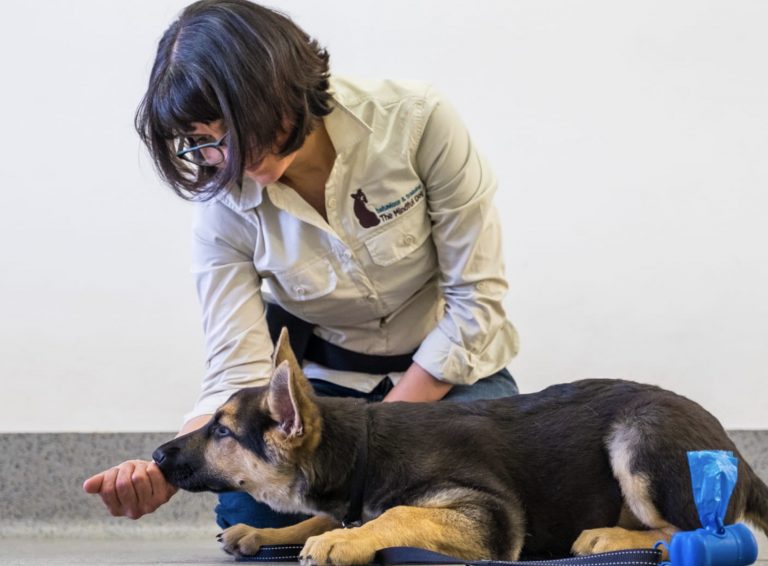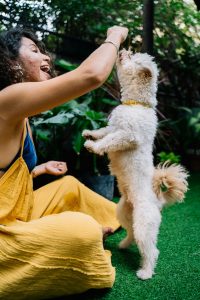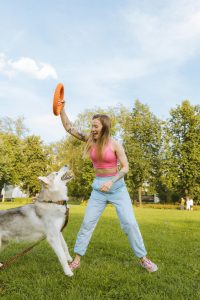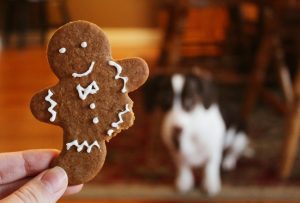How does your dog get his food? Do you put it in a dog’s bowl? Do you give him a command to start eating? Or it is free for all? What about hand feeding? Have you tried to hand feed your dog?
Hand feeding might be the most important part of training your dog. Without hand feed, your dog will not go for the lure and you cannot use it to encourage and reinforce good behavior.
A lot of trainers suggest hand-feed only for your dog. And they are onto something. The idea is to stop using a food bowl. You should feed your dog from your hands only.
Hand feeding might sound like something “too much hassle”. Yes, it is easier just to put your dog’s food in a dog’s bowl and give it to him. But hand feeding helps you solve many problems and improve your dog’s quality of life.
Try hand feeding your pet for one week, and you will have a completely different puppy. Today, we will talk about the benefits of hand feeding, and how to do it properly.
And if you want to know why should you do it, here is a quick summary of the benefits we will discuss later on. Hand feeding gives you instant control over what your dog eats, he doesn’t eat in a bowl, and your dog earns his food and has a sense of accomplishment. To put it simply, it is a fast and effective training method that you just have to have it in your arsenal.
Hand Feeding Explained
At a first glance, hand feeding sounds simple. And it is. Yet, so many owners still make mistakes when they hand feed their dogs.
So, what is the basic premise? Your dog eats out of your hand. We will leave the frequency up to you. Some choose to feed the majority of their dog’s food, while others do it just a couple of times per week. We suggest hand-feeding only in the first couple of weeks/months while your puppy gets used to the idea.
When you hold your dog’s food in your hand, you are allowing your dog to eat when she has calm manners. And that is essential for a good dog. Your pet learns to be calm around food. You will notice your dog’s manners starting to improve.
If your dog gets too nippy or grabby, you can simply pull away your hand and ask your dog to “be gentle” or “calm down”. And once your pet calms down, you can offer more food.
How to properly hand feed your dog
When you hand feed, you can get out of control. We admit it. That is why you have to do it properly. Here are some basic principles:
- Measure your dog’s meal and then give it from your hand
- Pull your hand away if your dog gets too pushy
- Put your hand down and allow your dog to eat only when he acts calm
- If your dog refuses to eat from your hand, do not push him. Let him go and try again later
- If your dog doesn’t want to eat from your hand, make him sit and see if he will take food as a reward
Now, start hand feeding at home. And once you get the hang of it, you can take it out on the walk. You can make your dog earn his dinner while you are walking. Of course, not his full dinner. But measure his food, and have some of it with you during walks. If your dog acts calmly, shows good manners, you reward him with food. But it is essential that you first do hand feeding at home.
Remember, when you are out on a walk, you reward a piece of kibble for doing stuff. You give him food as a consequence of the things he has to do outside.
And that is not just with dogs around. You reward with him doing stuff with only you and the environment. For example, your dog has to sit and look at you. Give him a piece of kibble. Continue walking, and stop after a minute or two. Give him kibble again.
Here is a great exercise, you can try this during your walk. Go on a walk, and bring a bag with kibble with you. Make sure there are no distractions around since your dog is in the early stages of dog training for this exercise.
Go on a one-mile walk. During that mile, stop every 20 to 30 yards, and make your dog sit and look at you. Reward him with a kibble. Do the math. How many times your dog repeats that exercise in a mile? That is 60 to 90 repetitions in one mile. Repeat it every day, and your dog’s behavior will vastly improve.
Then you add distractions. For example, have a friend walk with another dog, but your dog has to look at you. If the experiment doesn’t work, go back to the previous stage.
After a while, you will have a dog that will LOOK at you. And you have trained him to do it.
Why should you try hand feeding?
Simply put, there are no cons to hand feeding. Except only for the dirty hands. On the other hand, the benefits of hand feeding your dog include improved focus and impulse control, builds a great bond, builds trust, helps with fear and shyness in dogs, and slows down quick eaters. Let’s break them down.
Improve dog’s focus and impulse control
With hand feeding, it is easier to get your dog to focus on you. After all, food comes from you. And that instantly plays to your dog’s instinct to survive. Without food, he cannot survive.
Now, hand feeding is not an answer to all behavior issues. But it will vastly improve your dog’s focus on you.
Hand feeding is one of the most common training techniques for obedience class dogs. But it also works for dogs doing agility courses and service dogs.
Simply put, it is the best way to teach your dog manners around food and develop basic impulse control.
Creates a bond between you and your dog
When you get a pet in your home, your puppy doesn’t trust you instantly. Every new dog owner knows and has seen this. The puppy comes home, and in the first few days, he is a bit shy and might stay in bed.
As we said before, with hand feeding, you cater to your dog’s instinct to survive. And with this technique, you can instantly build up the relationship. It will improve your bond in a matter of days.
Slow down fast eaters
We have all seen videos of puppies going nuts over food. They eat an entire bowl of food in a matter of seconds. Well, do you know what happens when your pup eats too fast? Well, for starters, choking hazards. Flatulence and gases. When dogs eat fast they are less likely to chew up their food. It is the same as with humans.
For larger dogs, the risk of gas distension in the stomach and bloating is larger. In medical terms, when your large dog eats fast, the stomach becomes overstretched and rotated by excessive gas content. That can lead to a decreased return of blood to the heart and loss of blood to the stomach. And yes, it is a life-threatening condition that you can reduce with hand feeding.
Helps with shy dogs
We talked about creating and building up your bond with your dog. For dogs that have been under socialized, this is even more important. Think of stray dogs that have developed a fear of humans over the years.
Hand feeding is the way to improve that bond and make your pup trust you. No, this will not happen instantly. The dog will not instantly come to your hand and start eating.
You have to give him dog’s food but from your hand. Throw it, wait to see if he eats. Throw it closer to you. Then closer, and closer. And eventually, he will come to you.
Tricks to Try
With hand feeding you can improve your training. And that is arguably one of the main reasons to try it. For example, I use hand feeding to repeat some basic commands, like sit, come, lie down, stand, wait, and etc. And I do it during dinner.
Dogs have a sense of achievement when they perform well and get rewarded for it. Do you know that Latin phrase, Repetitio Est Mater Studiorum? It means “repetition is the mother of all knowledge”.
Repeating the basic commands every night means your dog will never forget commands like sit, come, and lie down.
Now, a few tricks here. You can work on eye contact and have your dog sit in front of you. Give your dog food as he stares at you. You can also work on commands like “leave it”. Hand feed your dog, drop a piece, tell your dog to leave it, and then after a few seconds, offer a handful of food as a reward.
With hand feeding for a couple of days, you will have a different dog. Your dog learns that food comes from your hand. And that helps you lure him with food and make him do anything you want.
Remember, some dogs take easier to hand feed than others. Some dogs might not want to eat from your hand in the beginning. Do not push it, come again later. No dog will starve himself. Even a fearful dog will accept meal eventually.
And from time to time, you can switch things up. For example, use a food-dispensing toy or a puzzle toy. But do not do it until your dog learns that food comes from you.
What to do if the dog doesn’t love food?
We touched on this subject a bit before, but let’s explain it. Many dog owners who try to train their dogs ask what they can do when their dog does not love food. Or he likes food, but will not take it in some situations. Yes, there are dogs that are picky eater.
Well, you have to do the temperament test. You offer your dog some food. But if he doesn’t get close to you, you offer him food at his place. Throw it next to him. If he takes it, he is cool. But if your new puppy doesn’t take the food, he is probably upset about the situation or the environment. This works with a rescue dog as well.
One way to make dogs love food is to use food as a reinforcement. What does that mean? Well, after you give your dog kibble, you follow it up with some mega treat. That way, the dog learns that “if I eat my kibble, I also get cheese after”? Most of us remember it, when we were kids, our parents told us to do our homework and then we can play.
It is the same basic premise. And it is not only treats that you can use. Eat the kibble, and then play a game. Which dog doesn’t love to play? Eat the kibble, and cuddle. You can add a sit command before eating the kibble to get the dog in a calm position.







